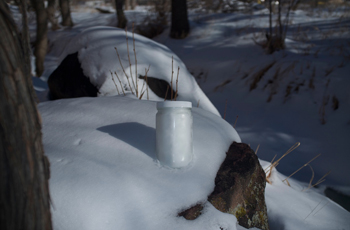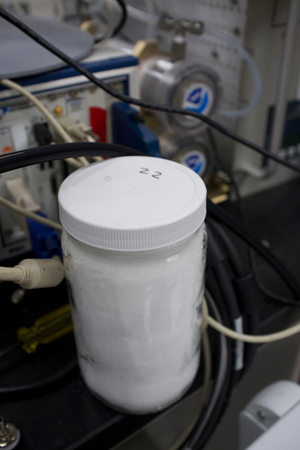2013 News & Events
Sizing up black carbon in snow
4 March 2013
modified from the stories by CIRES Communications and NOAA Communications

It is well known that white snow reflects sunlight and that dark material absorbs it. When black carbon particles in the atmosphere are deposited in and on snow and ice, they change the balance of reflection and absorption. Theory says that the size of the black carbon particles matters. A given weight of larger particles tends to absorb less sunlight than the same weight of smaller particles, because the interior of a larger particle is "shaded" by its own surfaces. Thus, larger particles would have a smaller warming effect on snow. But until now, researchers haven't measured the size of those dark particles in snow, and models assumed that they were similar to their size in the atmosphere.
Using an innovative approach, scientists have for the first time measured the size of black carbon particles in snow, and unexpectedly found that they are larger than the size typically observed in the air. This discovery will help researchers better account for how black carbon changes the climate-related properties of a snowy landscape. The study "Black carbon aerosol size in snow" was published online this month in Nature's Scientific Reports journal.
"For the first time, we looked at the size of these particles in snow, and found that they can be larger than in the air. This surprised us even more once we calculated the possible change in the amount of light they would absorb," said the study's lead author Joshua Schwarz. "This is important for our understanding of how black carbon interacts with the atmosphere and how it can affect climate."
Black carbon is a byproduct of combustion, from sources such as vehicle engines and cook fires. The small particles are released into the atmosphere and return to the Earth's surface in rain, snow or by colliding with the ground.

Scientists identified several mechanisms that could explain how the black carbon particles end up larger when they are in the snow, including smaller particles sticking together in the air; larger particles being more likely to be deposited in snow; and larger particles being formed in fallen snow that undergoes temperature fluctuations. However, they hypothesize that more complex interactions of the black carbon and snowflakes could be also be involved, likely as the snow is forming in the atmosphere. The size of the black carbon in snow contains a "fingerprint" of these interactions, providing hope that it can help improve scientists' understanding of how the particles are removed from the air.
To measure the size of black carbon particles – often referred to as "soot particles" – in the snow, researchers from NOAA, CIRES and STC used an instrument known as the Single Particle Soot Photometer (SP2). The SP2 is an innovative instrument that has flown aboard research aircraft and can determine the size of black carbon particles in the atmosphere. To measure black carbon particle size in snow, however, the scientists developed a method to apply the SP2 to measuring size in liquid samples (melted snow, for instance).
The researchers based their findings on snow samples gathered in Colorado, but also saw indications of the large black carbon sizes in snow from remote Arctic regions. Therefore, the researchers reason that formation of larger soot particles could happen over large regions of the globe.
While the scientists note that the climate warming due to black carbon in snow could currently be underestimated, they add that further work is needed to refine the estimate of 30 percent. "This piece of the puzzle opens the door to many questions," says Schwarz. "A next step is to pin down the implications for climate and understanding of black carbon removal from the air by snow."
J. Schwarz, R. S. Gao, A. E. Perring, J. R. Spackman, and D. W. Fahey, Black carbon aerosol size in snow Scientific Reports, doi:10.1038/srep01356, 2013.
Abstract
The effect of anthropogenic black carbon (BC) aerosol on snow is of enduring interest due to its consequences for climate forcing. Until now, too little attention has been focused on BC's size in snow, an important parameter affecting BC light absorption in snow. Here we present first observations of this parameter, revealing that BC can be shifted to larger sizes in snow than are typically seen in the atmosphere, in part due to the processes associated with BC removal from the atmosphere. Mie theory analysis indicates a corresponding reduction in BC absorption in snow of 40%, making BC size in snow the dominant source of uncertainty in BC's absorption properties for calculations of BC's snow albedo climate forcing. The shift reduces estimated BC global mean snow forcing by 30%, and has scientific implications for our understanding of snow albedo and the processing of atmospheric BC aerosol in snowfall.